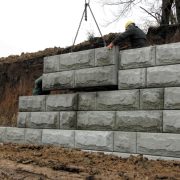When it comes to stabilizing sloped land or supporting heavy loads, not all retaining walls are created equal. You’ve probably seen different types — from timber and stone to modular block walls — but one material consistently stands out for strength, longevity, and versatility: concrete.
Concrete retaining walls are the go-to solution for both residential and commercial landscapes that need serious structural integrity. But what makes them so dependable? And how can they transform not just your property’s stability but also its visual appeal? Let’s discuss how these solid structures handle the toughest load-bearing challenges with ease.
Understanding the Purpose of Retaining Walls
Before we dive into why concrete is such a powerful choice, let’s quickly review what a retaining wall actually does. In simple terms, a retaining wall holds back soil or earth to prevent erosion, landslides, or uneven settling on sloped terrain. It helps transform steep, unusable ground into functional, stable, and often beautiful spaces.
From backyard terraces to industrial lots, retaining walls provide the foundation for driveways, walkways, gardens, and even buildings. They must resist the lateral pressure of soil and water pushing against them — and that’s no small task. This is where concrete proves its unmatched worth.
Why Choose Concrete Retaining Walls?
If you’re comparing materials for your retaining wall, it helps to understand what sets concrete apart. Here are the key reasons homeowners, engineers, and builders prefer it for load-bearing applications.
- Exceptional Strength and Load Capacity
Concrete is one of the strongest construction materials available. Its compressive strength allows it to withstand immense pressure from soil, water, and other environmental forces. Whether you’re stabilizing a steep slope or supporting a driveway above ground level, concrete offers reliable load-bearing performance.
2. Long-Lasting Durability
Unlike timber, which rots, or stone, which can shift over time, concrete is virtually weatherproof. It resists rot, pests, moisture, and UV damage. With proper installation and maintenance, a concrete retaining wall can last for 50 years or more, even in harsh climates.
3. Design Flexibility
Concrete isn’t just about raw strength — it’s also incredibly versatile in design. You can choose between poured-in-place walls, concrete block systems, or decorative precast panels to match your landscape. Textured finishes, stains, or veneers can even mimic natural stone for a refined look.
4. Minimal Maintenance
Once installed, concrete retaining walls require very little upkeep. They don’t need to be sealed or painted often, and their solid construction means there’s no risk of termites, rust, or rot. Periodic inspection and cleaning are usually all that’s needed.
5. Excellent Resistance to Erosion
Concrete performs exceptionally well in areas prone to water flow or heavy rain. When combined with proper drainage systems, it prevents soil washout, maintaining long-term stability even on challenging terrain.
Types of Concrete Retaining Walls
There isn’t just one way to build a concrete retaining wall. Depending on your site’s needs and design goals, you can choose from several structural styles. Let’s explore the most common ones.
1. Gravity Walls
These walls rely on their own weight to hold back soil. Built from massive concrete blocks or poured sections, gravity walls are thick and sturdy, ideal for smaller slopes and garden areas.
2. Cantilevered Walls
Cantilevered walls use a reinforced concrete base shaped like an inverted “T.” The weight of the soil pressing on the base actually helps stabilize the wall. This engineering design makes them efficient for medium to tall walls that handle substantial loads.
3. Counterfort Walls
For very high or heavy-duty applications — like highways or industrial sites — counterfort walls are used. They feature thin vertical slabs supported by internal triangular webs (counterforts) that reduce bending pressure. These are among the most structurally advanced retaining systems.
4. Piled or Anchored Walls
In areas where space is limited, engineers may use anchored or piled concrete walls. These rely on steel cables or deep foundation piles driven into the ground for added stability, perfect for high-load environments.
The Construction Process: Step by Step
Building a concrete retaining wall isn’t a simple weekend project — it requires planning, engineering, and precision. Here’s what you can typically expect during installation.
Step 1: Site Evaluation and Design
An engineer or contractor first assesses the site to evaluate soil type, slope, water flow, and load requirements. The design must account for lateral earth pressure and drainage to prevent wall failure.
Step 2: Excavation and Foundation
The foundation is the key to stability. Workers excavate a trench deep enough to support the wall’s height and weight, then pour a reinforced concrete footing that anchors the structure.
Step 3: Formwork and Reinforcement
Steel rebar reinforcement is installed to add tensile strength. For poured concrete walls, wooden or metal forms shape the structure before the concrete mix is poured in.
Step 4: Concrete Pouring and Curing
Concrete is poured into the forms and allowed to cure — a process that strengthens the material over time. Proper curing ensures durability and prevents cracks.
Step 5: Drainage Integration
Behind every well-built retaining wall lies a drainage system. This usually includes gravel backfill, perforated pipes, and weep holes that allow excess water to escape, reducing hydrostatic pressure.
Step 6: Finishing and Landscaping
Once the wall has cured, contractors may add finishing touches like texturing, staining, or cladding. Landscaping around the wall completes the transformation from a bare slope to a usable, visually appealing space.
Customizing the Look of Concrete Walls
While concrete is known for strength, it can also be surprisingly beautiful. Modern techniques allow for a range of aesthetic customizations, such as:
- Stamped concrete for stone or brick patterns
- Colored concrete using dyes or stains
- Exposed aggregate finishes for texture and character
- Stone veneers for a natural or rustic appeal
- Integrated lighting or seating for functional elegance
This means you don’t have to sacrifice style for strength. With the right design approach, your retaining wall can become a standout architectural element.
Where Concrete Retaining Walls Work Best
Concrete retaining walls are used in many settings, both residential and commercial. Some of the most common applications include:
- Driveways and parking lots requiring soil stabilization
- Hillside homes with steep terrain
- Commercial developments needing strong retaining systems
- Highway and bridge embankments
- Garden terraces and outdoor seating areas
Essentially, anywhere that demands high structural support, concrete walls deliver unmatched reliability.
Comparing Concrete to Other Retaining Wall Materials
Let’s briefly compare how concrete stacks up against other popular retaining wall materials:
| Material | Strength | Lifespan | Maintenance | Aesthetics | Ideal Use |
| Concrete | Very high | 50+ years | Low | Customizable | Heavy loads, tall walls |
| Timber | Moderate | 10–20 years | Medium | Natural, rustic | Small garden walls |
| Stone | High | 40+ years | Medium | Elegant, timeless | Decorative landscapes |
| Brick | Moderate | 20–30 years | Medium | Traditional look | Low-load areas |
Clearly, concrete stands out as the most durable and structurally capable choice when long-term performance is the priority.
Common Myths About Concrete Retaining Walls
Let’s address a few misconceptions that sometimes discourage people from choosing concrete.
Myth 1: Concrete looks plain and industrial.
Modern concrete can be colored, textured, or veneered to match any design style — from modern minimalism to rustic charm.
Myth 2: Concrete cracks easily.
Proper reinforcement and drainage prevent cracking. Most issues arise from poor installation, not the material itself.
Myth 3: It’s too expensive.
While the initial cost is higher than timber, concrete’s longevity and low maintenance make it a smarter long-term investment.
Maintenance Tips for Long-Lasting Performance
Though low maintenance, your concrete retaining wall will benefit from a few simple care habits:
- Inspect annually for cracks or movement.
- Ensure drainage outlets remain unblocked.
- Clean surfaces with mild detergent and water.
- Reapply sealant every few years to prevent moisture intrusion.
- Remove plant roots or weeds growing near the base.
Following these steps helps your wall maintain its strength and visual appeal for decades.
Environmental and Sustainability Benefits
Concrete retaining walls can also be environmentally responsible when designed thoughtfully. Using recycled materials in the mix, incorporating proper drainage, and reducing soil erosion all contribute to a more sustainable landscape.
Additionally, the durability of concrete means fewer replacements over time — translating to less waste and reduced resource consumption.
When to Consult a Professional
Because concrete retaining walls involve engineering calculations and safety considerations, it’s crucial to work with a qualified retaining wall contractor or structural engineer. They’ll ensure the design meets load-bearing requirements, complies with local building codes, and includes adequate drainage.
Attempting to build a concrete wall without expertise can lead to serious structural problems later on.
Homeowners and developers alike trust Rainier Rockeries for Concrete Retaining Walls in Bellevue, WA, due to their meticulous craftsmanship and attention to detail. Choosing their services guarantees both structural integrity and a polished, professional finish.
Final Thoughts
If your property requires a retaining wall that combines unmatched strength, long-term stability, and design versatility, concrete is the clear choice. It’s built to handle the heaviest loads while standing the test of time — rain, erosion, and shifting soil included.
Whether you’re a homeowner reclaiming a sloped yard or a builder developing commercial land, a concrete retaining wall offers more than just support — it delivers peace of mind, functionality, and enduring beauty.
So, if you’re ready to turn that uneven terrain into a stable, usable, and visually appealing space, consider investing in the strong, durable option that professionals trust: a concrete retaining wall. It’s a decision that pays off for decades to come.














Comments